
Condicinae is a subfamily of moths in the family Noctuidae. The subfamily was erected by Robert W. Poole in 1995.
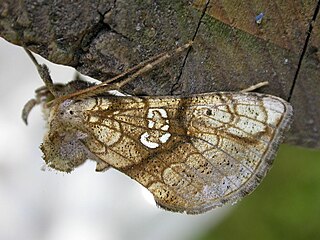
Polychrysia moneta, the golden plusia, is a moth of the family Noctuidae. It is found in the Palearctic realm.

Cerastis is a genus of moths of the family Noctuidae.

Zanclognatha is a genus of litter moths of the family Erebidae. The genus was erected by Julius Lederer in 1857.

Eucarta is a genus of moths of the family Noctuidae. The genus was erected by Julius Lederer in 1857.

Omphalophana is a genus of moths of the family Noctuidae.

Cucullia argentea, the green silver-spangled shark, is a moth of the family Noctuidae. The species was first described by Johann Siegfried Hufnagel in 1766. It is found in southern and central Europe through Siberia, Mongolia and Manchuria up to Korea and Japan.
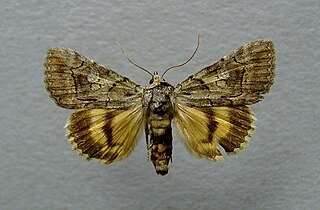
Catocala eutychea is a moth of the family Erebidae first described by Georg Friedrich Treitschke in 1835. It is found in the eastern parts of the Mediterranean, especially the Balkans.
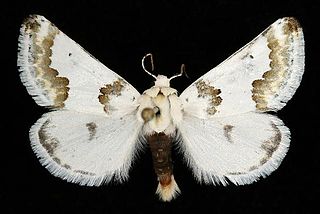
Schinia cumatilis, the silver-banded gem, is a moth of the family Noctuidae. The species was first described by Augustus Radcliffe Grote in 1865. It is found from the Southwestern United States into Southern Canada.

Schinia acutilinea, the angled gem or acute-lined flower moth, is a moth of the family Noctuidae. The species was first described by Augustus Radcliffe Grote in 1878. It is found in the dry southern portions of Saskatchewan, Alberta and British Columbia, south across the plains and Great Basin to southern Arizona and California.
Cucullia santonici is a moth of the family Noctuidae. It was traditionally found from southern Europe through parts of Near East and Middle East to China.

Ctenoplusia limbirena, the Scar Bank gem, or silver U-tail, is a moth of the family Noctuidae. It is found in south-western Europe, Africa, the Canary Islands, Arabia, the southern Himalayas, India, Sri Lanka, Indochina to south-eastern China, Taiwan, Sulawesi, Bali and Timor. In New Zealand, it has been established since 2011.
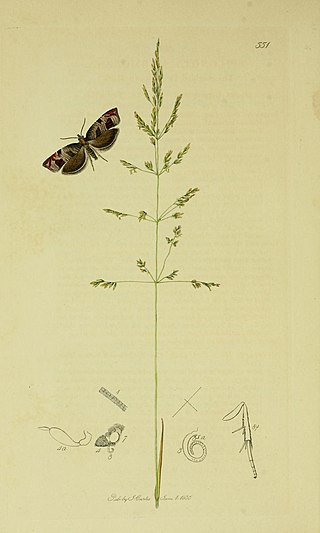
Acleris maccana, the marbled dog's-tooth tortrix, is a moth of the family Tortricidae. The species was first described by Georg Friedrich Treitschke in 1835. It is found from Europe, east across the boreal regions to Siberia. In North America it occurs across much of the boreal forest region, south in the mountains in the east.

Loxostege turbidalis is a species of moth in the family Crambidae. It was described by Treitschke in 1829. It is found in most of Europe, except Ireland, Great Britain, Norway, the Benelux and the Iberian Peninsula. It has also been recorded from Russia, Turkey, China and Japan.
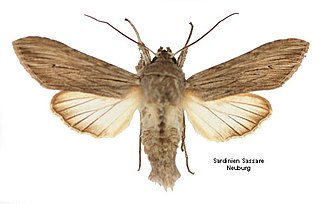
Cucullia tanaceti is a moth of the family Noctuidae. The species was first described by Michael Denis and Ignaz Schiffermüller in 1775.

Agrotis lata is a moth of the family Noctuidae. It was described by Georg Friedrich Treitschke in 1835. It is found in Algeria, Egypt, Libya, Morocco, Tunisia, Portugal and Spain, as well as on Sardinia, Sicily and Malta. It has also been recorded from Turkey and possibly Syria and Israel.
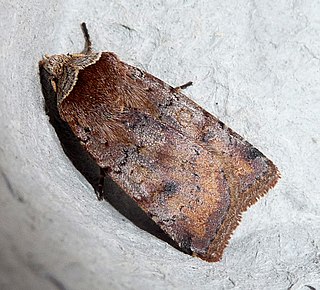
Cerastis faceta is a moth of the family Noctuidae. It was described by Treitschke in 1835. It is found in Morocco, Algeria, Tunisia, Spain, Portugal, France, Italy, as well as on Corsica, Sardinia, Malta and Sicily.

Aethes kindermanniana is a species of moth of the family Tortricidae. It was described by Treitschke in 1830. It is found on Sardinia and in Denmark, Germany, France, Spain, Italy, Switzerland, Austria, the Czech Republic, Slovakia, Poland, Hungary, Romania, Norway, Sweden, Finland, the Baltic region, Ukraine, Russia. and Asia Minor. It has also been recorded from North America.

Eucarta amethystina is a moth in the family Noctuidae first described by Jacob Hübner in 1803. It is found in central Europe, east to Belarus, through the Ural to the Pacific Ocean.

Grapholita gemmiferana is a species of moth of the family Tortricidae.


















